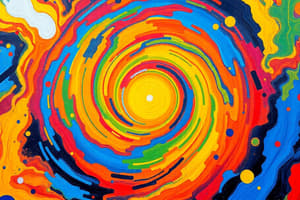Podcast
Questions and Answers
What is the estimated age of the universe according to the Big Bang Theory?
What is the estimated age of the universe according to the Big Bang Theory?
- 12 billion years
- 10 billion years
- 13.8 billion years (correct)
- 15 billion years
The Big Bang Theory describes the universe as starting from a literal explosion.
The Big Bang Theory describes the universe as starting from a literal explosion.
False (B)
Who proposed the Cosmic Inflation Theory?
Who proposed the Cosmic Inflation Theory?
Alan Guth and Andrei Linde
The Steady State Theory suggests that the universe has a definite beginning and end.
The Steady State Theory suggests that the universe has a definite beginning and end.
Which theory was first proposed by Sir James Jeans in 1920?
Which theory was first proposed by Sir James Jeans in 1920?
What does the Nebular Hypothesis suggest about the formation of the solar system?
What does the Nebular Hypothesis suggest about the formation of the solar system?
Who developed the Planetesimal Theory?
Who developed the Planetesimal Theory?
The Gaia hypothesis states that organisms interact with their ______ surroundings.
The Gaia hypothesis states that organisms interact with their ______ surroundings.
What is the solid portion of the Earth called?
What is the solid portion of the Earth called?
The oceanic crust is thicker than the continental crust.
The oceanic crust is thicker than the continental crust.
Who discovered the Mohorovicic Discontinuity?
Who discovered the Mohorovicic Discontinuity?
What percentage of Earth's total volume is made up by the mantle?
What percentage of Earth's total volume is made up by the mantle?
Match the following layers of the Earth with their descriptions:
Match the following layers of the Earth with their descriptions:
What is the composition of the outer core?
What is the composition of the outer core?
Flashcards are hidden until you start studying
Study Notes
Formation of the Universe
- Big Bang Theory: Universe's expansion began approximately 13.8 billion years ago; it is not a literal explosion but a rapid expansion of space.
- Cosmic Inflation Theory: Proposed by Alan Guth and Andrei Linde in the 1980s. Early universe was a rapidly expanding vacuum bubble, leading to a big bang after cooling and energy conversion.
- Steady State Theory: Universe is constantly expanding with new matter formation; has no beginning or end. Developed by Sir James Jeans and later revised by Sir Fred Hoyle and others in 1948.
Formation of Solar System
- Nebular Hypothesis: Developed by Immanuel Kant and Pierre-Simon Laplace in the 18th century; proposed that the solar system formed from a rotating cloud of gas and dust (nebula) about 4.5 billion years ago.
- Planetesimal Theory: Proposed by Viktor S. Safronov in 1941, and developed by T.C. Chamberlin and F.R. Moulton; suggests planets formed from the accretion of small space bodies in the early solar system.
- Tidal Theory: Developed by James Jeans and Sir Harold Jeffreys in 1917; posits that a close encounter with a star caused matter to be drawn from the sun.
The Beginnings of Earth
- Earth began as a hot gaseous mass from the solar nebula, similar to other planets.
Uniqueness of Earth
- Earth supports life; it is a dynamic system where energy flows continuously. Water is essential for life.
Earth Systems
- Earth's System: Involves the interaction of physical, chemical, and biological processes. Key components include:
- Atmosphere
- Geosphere
- Hydrosphere
- Biosphere
- Gaia Hypothesis: Posits that living organisms interact with their inorganic surroundings, creating a self-regulating system maintaining life-supporting conditions.
Geosphere Structure
- Crust: 5-70 km thick layer consisting of oceanic and continental crust; mostly composed of oxygen, silicon, aluminum, iron, calcium, sodium, potassium, and magnesium.
- Mohorovicic Discontinuity (Moho): Divides crust from mantle, discovered by Andrija Mohorovicic in 1909.
- Mantle: Largest part of Earth, making up 84% of total volume; composed of solid rock. The asthenosphere beneath the crust is ductile due to extreme heat and pressure.
- Gutenberg Discontinuity: Transitional boundary between mantle and core, named after discoverer Beno Gutenberg.
- Core: Composed of iron and nickel; outer core is liquid, while inner core is solid.
- Lehmann Discontinuity: Transitional boundary between the inner and outer core, discovered in 1929 by Inge Lehmann during a significant earthquake event.
Hydrosphere
- Represents the total water present on Earth.
Studying That Suits You
Use AI to generate personalized quizzes and flashcards to suit your learning preferences.




